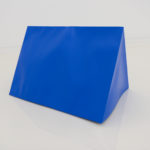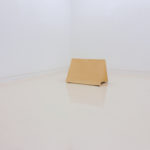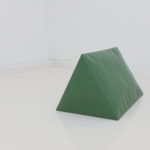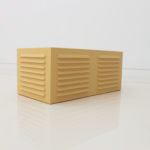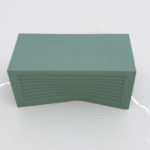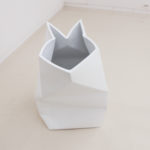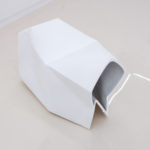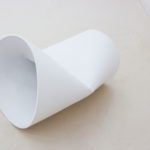Res Nullius
Nathaniel Robinson
2 May-10 June 2022
About a month before the show was scheduled to open, Nathaniel Robinson sent me an artist's note on his show, Res Nullius. The note looked like a page of endnotes attached to the end of a chapter; each sentence on the page was numbered. Only the essay seems to be missing. His artist's note—an occasional writing project for artists—felt more like a formal decision that he would make on his sculptures. Of course, the essay here is his show. There are nine sculptures in the show which are cast without originals. (Really, there was no clay original or anything like that. He made the molds first which are the negative space without modeled volumes.) His notes that resemble endnotes echo the way his sculptures were made. Everything Robinson does feels painfully empty like a lonely American landscape.
Res Nullius is an ancient Roman law term that means nobody's thing. In fact, there is an actual footnote in his note which is a list of definitions of Res Nullius. According to the definition listed in his note, it basically means a thing with no importance or property not owned by anyone. It is a thing unwanted, abandoned, or lost. In the show, there are three tents, two crushed milk cartons, two louvers—one dented, the other intact—a crushed cup, and a milk jug. Each sculpture is about the same size: tents are reduced in size; milk cartons are blown up. We have seen sculptures made bigger or smaller than the original, like a blown-up safety pin by Oldenburg or a diminutive room created in a box by Cornell. Robinson's objects seem to be sized differently for different reasons. He seems to say that these things might be of little importance but, at the same time, they are of the same importance. They are all real. It is as if they were seen by a kid who looks at these things with the same amount of wonder without knowing their value in the real world.
Ownership can be discussed on many different levels. Yet, why does Robinson bring up this subject? What aspect of ownership does he want to talk about? Does he want to critique our behavior as mindless consumers? When I first saw this series of sculptures, I noticed a mint-colored, box-like work titled Unit (Introvert, Indented). This object I vaguely remember seeing somewhere enclosing an AC suggests a personality and an injury. It is amazing how instantly I felt pain. I immediately felt sympathy for this box and realized I, too, am as abandoned and damaged as this box. But was I ever owned by someone to feel abandoned? Is this feeling close to what Heidegger meant by thrown-ness? Is this indented box a manifestation of our own existence in the world?
Robinson may have wanted to be more specific about the existential tone that these objects exude. In his note, he announces that Res Nullius is a threshold, which suggests the period of limbo before ownership claims an object. Though they take the shapes of milk cartons and tents, they are artworks carefully and thoughtfully made, packed, transported, and laid on the floor, waiting to be sold and owned by strangers. These sculptures are, however, the shapes and contours of the artist's mind. But as naive as this might sound, can an artist's mind be sold and owned? Are we all a bunch of minds waiting to be sold?
The last two endnotes on his work are anecdotal scenes rather than definitions. He reminisces a couple of scenes of his childhood: what the sidewalks in his neighborhood looked like; how he dropped a milk jug on his way home from the store. As a young child, he must have bent close to the ground and looked at it. These sculptures are laid on the floor, like discarded objects on the street or yard as the title suggests. One might remember an empty Sunday morning that one walks out onto. Houses, buildings, and trash cans suddenly look unfamiliar—jamais-vu— as if they don't belong anywhere. Upon entering the gallery, one might feel like walking into an uncanny landscape like that, as we saw in Edward Hopper or William Eggleston's. The milk jug might relate to the artist's childhood memory, but it really doesn't belong anywhere. It has left the artist's mind and hands and is here on the gallery floor now. But it also doesn't belong here either. It is on its own, in its own abstract form, occupying a certain amount of space, claiming its mysterious presence.
—Mimi Park
전시 오픈 한 달 전쯤 나다니엘 로빈슨이 자신의 전시, 《레스 눌리우스(Res Nullius)》에 관한 작가 노트를 보내왔다. 그의 글은 마치 책의 한 챕터 뒤에 첨부되는 각주 페이지 같아 보였다. 정작 본문은 빠진 채 말이다. 그의 작가 노트(작가들이 가끔 하게 되는 작문 프로젝트)는 그가 조각을 만들 때 했던 형식적인 결정에 가까워 보였다. 물론 여기서 '본문'은 그의 전시일 수 있다. 전시에는 모두 아홉 점의 조각이 전시되었는데, 이들은 모두 원본 없이 주조된 것이다.(정말로, 원본이 되는 흙 조각이나 그런 것은 없었다. 그러니까 그는 양각 없이 몰드라는 음각을 먼저 만들고 그 안에 재료를 넣어 바로 주조한 것이다.) 원본 없는 각주처럼 보이는 그의 글은 그의 조각을 닮아있다. 로빈슨이 하는 모든 것은 미국의 외로운 풍경처럼, 가슴이 서늘할 정도로 비어있다.
레스 눌리우스는 고대 로마법의 용어로 '누구의 소유도 아닌 물건'이라는 뜻이다. 실제로 로빈슨의 노트에는 각주가 하나 달려있는데, 여기엔 레스 눌리우스의 정의들이 열거되어 있다. 여기 열거된 정의에 의하면 레스 눌리우스는 기본적으로 하찮은 물건 또는 소유주가 없는 물건을 뜻한다. 전시에는 세 점의 텐트, 두 점의 찌그러진 우유갑, 두 개의 미늘 판자 상자(하나는 찌그러지고 다른 하나는 멀쩡한) 그리고 찌그러진 컵과 우유 통 모양의 조각이 포함되었다. 그런데 이들은 모두 비슷한 크기다. 그러니까 텐트는 크기가 작아진 것이고, 우유갑은 커졌다. 우리는 본래 오브제의 크기보다 크기가 커지거나 작아진 조각품들을 보아왔다. 올덴버그가 만든 거대한 옷핀이나 코넬이 만든 작은 상자 속 방처럼 말이다. 로빈슨의 조각들은 다른 이유로 크기가 달라진 듯하다. 그는 이 물건들이 매우 하찮은 물건이지만, 다 똑같이 중요하다고 말을 하는 것 같다. 이들은 모두 '리얼'하다. 마치 어린아이가 세상 속 가치는 모르는 채 그저 똑같은 경이로움으로 바라본 물건들 같다.
소유란 여러 차원에서 논의될 수 있다. 그런데 왜 로빈슨은 이 주제에 대해 말하고 싶었을까. 소유의 어떤 측면을 얘기하고 싶었을까. 우리가 아무 생각 없는 소비자이고 너무 많이 버린다고 하고 싶었을까? 내가 이 조각 시리즈를 처음 보았을 때 민트색의 상자 같이 생긴, 〈유닛(내성적, 푹 들어간)〉이라는 작업에 주목했었다. 어디선가 에어컨을 담고 있는 이렇게 생긴 상자를 본 것 같은데, 찌그러진 상자에 사람의 성격, 그리고 부상의 흔적을 부여한 것이다. 상자였을 뿐인데도 얼마나 바로 아픔을 느꼈는지 나도 신기할 정도다. 그 상자도 불쌍하고, 나도 그 상자처럼 찌그러지고 버려진 게 아닐까 싶었다. 하지만 내가 버려지게, 누가 날 소유한 적이 있었을까? 이런 기분이 하이데거가 말한 '내던져짐'인가? 이 찌그러진 상자는 세상 속 우리 실존의 현현인가?
로빈슨은 아마도 이 조각들이 내뿜는 실존적 느낌에 대해 더 구체적으로 말하고 싶었을지도 모른다. 그의 노트에서 그는 '레스 눌리우스'가 경계에 있는 어떤 것이라고, 소유권이 행사되기 전에 물건이 처한 어정쩡한 상황이라고 선언한다. 이 조각들은 우유갑이나 텐트의 형태를 띠지만, 아주 조심스럽고 계획적으로 만들어지고, 포장되고, 운송되어 지금은 갤러리의 바닥에 놓여, 팔릴 것을 기다리고 있다. 모르는 사람의 소유가 될 것을 기다리며 말이다. 하지만 이들이 작가가 만들어낸 형태이고 윤곽인 것을 생각하면, 결국, 순진하게 들릴지도 모르지만, 예술가의 정신이 팔리고 소유될 수 있다는 얘기인가? 우리가 모두 결국 그런 상황에 있는 것인가?
그의 '각주' 중 마지막 두 개는 설명이나 정의가 아니라 일화적인 장면들, 어린 시절의 두 장면에 관한 것이다. 그가 어렸을 때 동네에 있던 보도블록이 어떻게 생겼었는지, 가게에 심부름을 다녀오다가 1갤런짜리 우유 통을 떨어뜨린 기억이 그것이다. 작은 아이였기에 아마도 바닥이 가깝게, 잘 보였었을 것이다. 이 조각들은 바닥에 놓여있다. 제목에서 암시하는 것처럼 바닥에 버려진 물건들처럼 말이다. 우연히 나간, 이른 일요일 아침의 거리를 기억하는지 모르겠다. 집과 건물과 쓰레기통이 갑자기 낯설어 보이는 것을, 그들이 갑자기 딴 세상에 속한 것들처럼 보였던 것을 말이다. 갤러리에 들어서면, 아마 조금 딴 세상 같은 풍경으로 들어가는 듯 느낄지도 모르겠다. 에드워드 호퍼나 윌리엄 이글스턴의 작품 속에서 본 것 같은 풍경 말이다. 여기서 우유 통이 작가의 기억과 관련이 있지만, 실제로 우유 통은 어디에도 속하지 않는 물건이다. 작가의 머릿속, 그의 손을 떠나 이제 갤러리 바닥에 놓여있다. 하지만 어디에도 속하지 않는다. 그것 그대로의, 그 추상의 형태를 띠고, 어느 정도의 공간을 차지하며, 알 수 없는 존재감을 지닌 채 바닥에 놓여있다.
박상미
